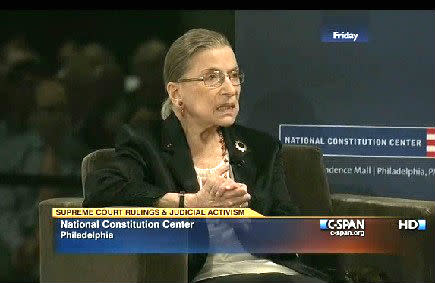Video: Justice Ginsburg on DOMA and Roe v. Wade
Justice Ruth Bader Ginsburg explains why she voted to strike down the Defense of Marriage Act, and her past comments about the Roe v. Wade decision as going “too far.”
Jeffrey Rosen, the Center’s chief executive officer, interviewed Justice Ginsburg for about 90 minutes before a sold-out audience in Philadelphia.
Related Videos: Ginsburg on Judicial Activism | Ginsburg on Affirmative Action
And the topics of the Windsor case, which ended the Defense of Marriage Act, came up, along with the Justice’s well-cited comments on the Roe decision.
“We were very well informed,” Ginsburg said about the numerous briefs the Supreme Court received in the Windsor case.
When asked by Rosen why her vote to strike down the Defense of Marriage Act wasn’t an act of judicial activism, Ginsburg said cited a 1938 reference to comments from Justice Harlan Stone about making sure Congress respected the fundamental rights of citizens.
“Because the Defense Of Marriage Act was violating the equality that liberty guarantees, that fell into what I could call Justice Stone’s first category: The Court has to be careful to see that Congress is not treading on our most fundamental human values,” she said.
“DOMA wasn’t the first time the Court encountered this question. It wasn’t so long ago that many states made consensual sodomy a crime. In the [Bowers v. Hardwick] case [the Court said] it’s OK to express moral disapproval of that kind of activity. And then the Court turned around in the Lawrence case. … The themes in DOMA had already been stated.”
Ginsburg then talked about how her views on DOMA and the historic Roe v. Wade decision on abortion differed. The Justice has been quoted as saying that the Roe decision in 1973 went “too far, too fast.”
“The Court is a reactive institution. You react to the controversies that our brought to the Court. In DOMA there was a couple claiming that their marriage had the same right to be recognized by government as anyone else’s. So the only way that case could be resolved is by saying that … DOMA is unconstitutional,” she said.
“In Roe v. Wade, I should be very clear, the result was absolutely right. Texas had the most extreme law in the nation. A woman could not get an abortion unless it was necessary to save her life. It didn’t matter whether she would be left infirm; whether the conception was the result or rape or incest. The Court could have decided that case before it, which is how it usually operates. It should have said that law, Texas law, is unconstitutional. It didn’t; there was no need to declare every law in the country, even most liberal, unconstitutional. That’s not the way the court usually operates,” she said.
“It doesn’t take giant steps. This was an issue that was in flux all over the country in state legislatures. Sometimes the women were winning, sometimes they were losing. They were getting political experience, which was a good organizing tool. And then the Supreme Court said, ‘you won.’ And it gave the opposition one single target to hit at.”
She also said the actual Roe case was presented as a doctor’s rights case, when it really could be considered as a gender discrimination case.
“It’s a woman’s right to control her own destiny, to be able to make choices without the Big Brother state telling her what she can and cannot do,” she said to sustained applause.
Recent Constitution Daily Stories
Justice Ruth Bader Ginsburg talks about judicial activism
Video: Ginsburg explains Stone as inspiration for Fisher dissent
Is this President Obama’s “Eisenhower moment”?
Vote Now: An amendment to ban desecration of the American flag


